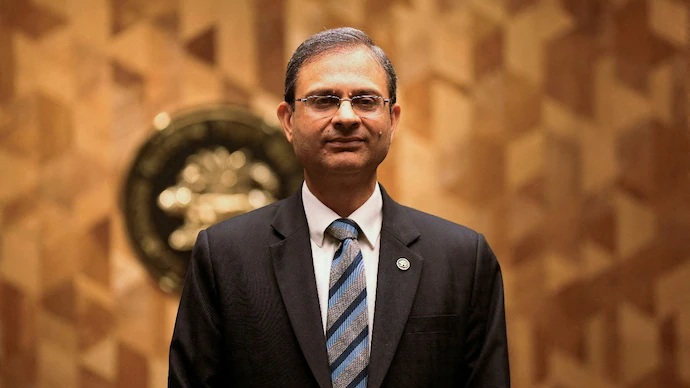RBI Governor Sanjay Malhotra addresses US tariffs’ impact on India’s economy, inflation, growth, and rupee at the August 2025 MPC meeting.

Will US Tariffs Hurt India’s Economy? RBI Governor’s August Update
On Wednesday, August 6, 2025, Reserve Bank of India (RBI) Governor Sanjay Malhotra concluded the central bank’s three-day Monetary Policy Committee (MPC) meeting by highlighting the risks posed by US tariffs to India’s economic growth. With the policy repo rate held steady at 5.5%, all eyes turned to what Malhotra said about inflation, trade tensions, and India’s global standing, especially after a controversial comment by US President Donald Trump, who recently referred to India as a “dead economy.”
Here’s what the RBI Governor had to say—and what it means for India.
📉 H2: RBI Holds Repo Rate, Flags Growth Risks from US Tariffs
In a unanimous decision, the RBI kept the key lending rate (repo rate) at 5.5%, continuing with a neutral policy stance amid global volatility and a challenging macroeconomic environment.
“The MPC met on the 4th, 5th, and 6th of August. After a detailed assessment, it voted unanimously to keep the policy repo rate unchanged at 5.5%,” said Governor Malhotra.
Supporting rates also remained steady:
- Standing Deposit Facility (SDF): 5.25%
- Marginal Standing Facility (MSF) and Bank Rate: 5.75%
He emphasized that the committee will remain data-driven, staying alert to shifts in both domestic and global dynamics.
🌍 H2: US Tariffs a Major Concern for India’s Growth
H3: Trade Tensions Could Stall Growth Momentum
Malhotra strongly flagged global trade disruptions as a growing concern, specifically referencing the recent tariff announcements by the US targeting Indian exports in sectors like pharmaceuticals, electronics, textiles, and gems.
Prospects of external demand remain uncertain amidst ongoing tariff announcements and trade negotiations. The headwinds from prolonged geopolitical tensions and volatile financial markets pose risks to the growth outlook,” Malhotra warned.
Despite India’s relatively low export-to-GDP ratio (~12%), compared to global peers like China (19%) or Germany (35%), the tariff war could ripple across key sectors and foreign exchange inflows.
📊 H2: GDP Growth Forecast Maintained at 6.5% Despite Tariffs
The RBI retained its FY2025–26 real GDP growth forecast at 6.5%, reflecting cautious optimism backed by domestic resilience. Quarterly projections are:
- Q1: 6.5%
- Q2: 6.7%
- Q3: 6.6%
- Q4: 6.3%
Additionally, the Q1 FY2026–27 projection stands at 6.6%.
Malhotra said domestic factors like a good monsoon, rising capacity utilization, and robust government capex are aiding recovery.
“Construction and trade are expected to drive services growth in the coming months,” he added.
📈 H2: Inflation Under Control but Food Prices Remain Volatile
The headline inflation has dropped significantly in recent months, offering room for the RBI to pause aggressive rate cuts. However, volatile vegetable prices remain a challenge.
- Core inflation: Steady around 4%
- Headline inflation: May rise in late FY2025–26
“Headline inflation is much lower than projected earlier, mainly due to volatile food prices. Core inflation remains within the expected range,” Malhotra noted.
The central bank has already slashed interest rates by 100 basis points since February 2025, with its impact still playing out.
🌐 H2: Global Uncertainty Adds to the Policy Challenge
Malhotra painted a mixed global picture—while political tensions have eased slightly, economic uncertainties persist. He noted that policymakers globally are grappling with low growth, sticky inflation, and high public debt.
“Over the medium term, the Indian economy holds bright prospects in the changing world order,” Malhotra asserted. “India is drawing on its inherent strength, robust fundamentals, and comfortable buffers.”
🇮🇳 H2: India’s Global Contribution Now Outpaces the US
In a strong rebuttal to President Trump’s remarks on India’s economy being “dead,” Malhotra emphasized India’s contribution to global economic growth.
“We are contributing about 18%, which is more than the US, where the contribution is expected to be much less – about 11%,” he told reporters.
His comment echoes sentiments from recent World Bank and IMF reports that praise India’s resilience, especially in services, manufacturing, and digital infrastructure.
US Tariffs News (Reuters)
🔗 Reuters on US tariffs and India
🔢 H2: Key Takeaways at a Glance
📌 RBI’s August 2025 MPC Summary:
- Repo Rate: 5.5% (unchanged)
- Inflation: Under control, though food prices are volatile
- GDP Growth Forecast FY26: 6.5%
- Risks: US tariffs, global trade tensions, financial volatility
- Next MPC Meeting: Sept 29 – Oct 1, 2025
❓ H2: FAQs – India, US Tariffs & RBI’s Outlook
Q1: Will US tariffs impact India’s GDP growth?
Yes, the RBI sees tariffs as a risk to external demand, which may impact GDP, though the domestic economy remains resilient.
Q2: Did the RBI change interest rates in August 2025?
No. The repo rate was held at 5.5%, with the central bank opting for a neutral stance due to global uncertainty.
Q3: How is inflation currently behaving in India?
Headline inflation has dropped due to easing core prices, though food inflation, especially vegetables, remains volatile.
Q4: Is India’s global economic contribution higher than the US?
According to Governor Malhotra, India contributes 18% to global growth, surpassing the US’s 11% in the current outlook.
Q5: When is the next RBI MPC meeting scheduled?
The next MPC meeting is scheduled for September 29 to October 1, 2025.
📣 Call to Action (CTA)
👉 What do you think about the US tariffs?
Will India emerge stronger despite global headwinds? Drop your thoughts in the comments, share this article, and follow QuickNews Press for real-time updates on India’s economic trajectory!


